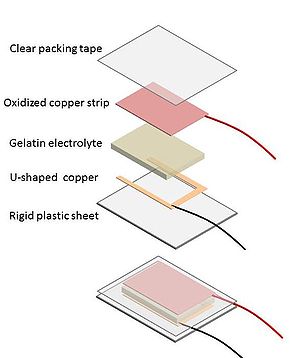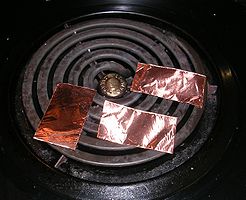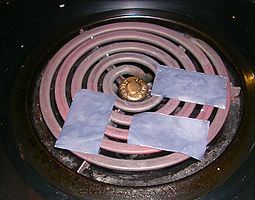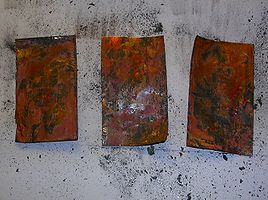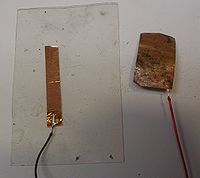Difference between revisions of "Cuprous Oxide Solar Cell"
Cmditradmin (talk | contribs) m (→Construction) |
Cmditradmin (talk | contribs) m (→Construction) |
||
| (26 intermediate revisions by the same user not shown) | |||
| Line 10: | Line 10: | ||
=== Overview === | === Overview === | ||
[[Image:Cell.jpg|thumb|200px|Finished copper solar cell ]] | [[Image:Cell.jpg|thumb|200px|Finished copper solar cell ]] | ||
This simple demonstration cell is actually a solar enhanced battery, but it teaches about semiconductors, electrolytes and oxidation and reduction. | |||
When copper metal is oxidized it can take several oxidation states. | When copper metal is oxidized it can take several oxidation states. | ||
| Line 20: | Line 22: | ||
: 4 Cu + O<sub>2</sub> → 2 Cu<sub>2</sub>O. | : 4 Cu + O<sub>2</sub> → 2 Cu<sub>2</sub>O. | ||
Cuprous oxide is a semiconductor. It has a bandgap between it ground state and its conduction band. Without light some electrons are able to jump the band and it acts as a battery. With light the cuprous oxide jumps to the conduction band and increased electricity flows. In this design the charge moves through a gelatin electroylte and to a non oxidized collection electrode. Using a gelatin electrolyte is less messy that a purely liquid electrolyte. A solid clear conductor is not great for this application because it can not make uniform contact with the copper surface. | Cuprous oxide is a semiconductor. It has a bandgap between it ground state and its conduction band. Without light some electrons are able to jump the band and it acts as a battery. | ||
Here are the half reactions | |||
:<math>Cu^{2+} + e^- \rightarrow Cu_{(s)} .34 V\,\!</math> | |||
and | |||
:<math>Cu_{(s)} + O_2 \rightarrow CuO_2 -.34 V\,\!</math> | |||
With light the cuprous oxide jumps to the conduction band and increased electricity flows. In this design the charge moves through a gelatin electroylte and to a non oxidized collection electrode. Using a gelatin electrolyte is less messy that a purely liquid electrolyte. A solid clear conductor is not great for this application because it can not make uniform contact with the copper surface. | |||
<br clear='all'> | |||
=== Materials === | === Materials === | ||
[[Image:Thincell.jpg|thumb|300px| ]] | |||
*Copper foil (snail tape) from the gardening store | *Copper foil (snail tape) from the gardening store | ||
*Wires and solder | *Wires and solder | ||
*Clear rigid plastic sheet (old cd case, or plastic lid from salad container.) | *Clear rigid plastic sheet (old cd case, or plastic lid from salad container.) | ||
*clear plastic packing tape | *clear plastic packing tape | ||
*clear gelatin | *clear gelatin or tissue paper | ||
*table salt | *table salt | ||
*volt meter | *volt meter | ||
<br clear='all'> | |||
=== Construction === | === Construction === | ||
'''The cuprous oxide''' | '''The cuprous oxide''' | ||
*Cut a 2" x 1" strip of the copper foil and remove the adhesive back. | *Cut a 2" x 1" strip of the copper foil and remove the adhesive back. | ||
*Place the foil sticky side up on an stove element under a stove hood fan. When the adhesive burns off a nasty black smoke is produced be sure to do this step with ventilation or out of doors. | *Place the foil sticky side up on an stove element under a stove hood fan. When the adhesive burns off a nasty black smoke is produced be sure to do this step with ventilation or out of doors. | ||
| Line 41: | Line 54: | ||
*After the strip cools down gently rub the surfaced with a paper towel to flake off the black cupric oxide and reveal the red cuprous oxide underneath. | *After the strip cools down gently rub the surfaced with a paper towel to flake off the black cupric oxide and reveal the red cuprous oxide underneath. | ||
<br clear='all'> | |||
<gallery widths=300px heights=200px perrow=3> | |||
Image:Burnerbefore.jpg|Copper before heating | |||
Image:Burnerhot.jpg|copper coated with cupric oxide | |||
Image:Oxidized.jpg|scraped copper revealing cuprous oxide underneath</gallery> | |||
<br clear='all'> | <br clear='all'> | ||
'''The gelatin electrolyte''' | '''The gelatin electrolyte''' | ||
[[Image:Gelsheet.jpg|thumb|200px|Gelatin electrolyte sheet on aluminum foil ]] | [[Image:Gelsheet.jpg|thumb|200px|Gelatin electrolyte sheet on aluminum foil ]] | ||
*Make a small batch of electrolyte gelatin by mixing a packet of clear gelatin and 1/4 cup of water and a tablespoon of table salt. | *Make a small batch of electrolyte gelatin by mixing a packet of clear gelatin and 1/4 cup of water and a tablespoon of table salt, approximately a 15% salt solution. | ||
*Heat this pot on the stove or in a cup in the microwave until the solution is dissolved and clear. | *Heat this pot on the stove or in a cup in the microwave until the solution is dissolved and clear. | ||
*Pour the gelatin on to a sheet of aluminum foil to create a layer about 1/8 and 1/4 | *Pour the gelatin on to a sheet of smooth sheet of aluminum foil to create a layer about 1/8" and 1/4" thick. You can fold up the edges of the foil to make a tray. | ||
*After the gelatin sets you should be able to peel away a leathery sheet of the material | *After the gelatin sets you should be able to peel away a leathery sheet of the material and handle it delicately. | ||
'''Tissue paper electrolyte''' | |||
An even simpler alternative is to sandwich a single layer of facial tissue or toilet paper between the cuprous coated electrode and the unoxidized (shiny) copper electrode. Seal the cell on 3 sides with clear packing tape so that the two electrodes have one edge exposed. Then drip the 15% salt solution into the space between the electrodes. Attache alligator clips to the two electrodes. The tissue paper holds the electrolyte against the oxide layer and the shiny electrode and it virtually transparent thus letting light through. | |||
<br clear='all'> | <br clear='all'> | ||
'''Assembly''' | '''Assembly''' | ||
| Line 61: | Line 82: | ||
*Clean a corner with sandpaper and solder another wire to one corner of oxidized strip. | *Clean a corner with sandpaper and solder another wire to one corner of oxidized strip. | ||
*Cut a piece 3"x 2" of rigid plastic. | *Cut a piece 3"x 2" of rigid plastic. | ||
Attach the | *Attach the a strip or U shaped electrode of new copper to the rigid plastic using the adhesive on the back of the copper. | ||
*Gently cut a 1" x 2" section of gelatin electrolyte with a knife and place this on the | *Gently cut a 1" x 2" section of gelatin electrolyte with a knife and place this on the shiny electrode. | ||
*Place the | *Place the oxidized copper strip on top of the gelatin electrolyte making sure that it is completely separated from the shiny electrode by the gelatin layer | ||
*Take single piece of plastic packing tape and carefully cover the electrode | *Take single piece of plastic packing tape and carefully cover the electrode and gel sandwich so that the tape seals to the plastic sheet on all sides. This prevents the gelatin from drying out and helps keep the electrodes in contact with the gel layer. | ||
[[Image:Cell.jpg|thumb|200px|regular and oxidized electrodes ]] | [[Image:Cell.jpg|thumb|200px|regular and oxidized electrodes ]] | ||
<br clear='all'> | |||
'''Testing''' | '''Testing''' | ||
*Now measure the current from the two wires. | *Now measure the current from the two wires. | ||
| Line 71: | Line 93: | ||
=== Links === | === Links === | ||
[http://www.linux-host.org/energy/asolcell.html Cuprous Oxide Cell in pop bottle] | |||
[http://www.linux-host.org/energy/aflatcell.html Cuprous Oxide Foil Cell flat version] | |||
[http://mrl.upesh.edu.pk/Files/jpms3/SOMEMETHODOLOGIES.pdf Advance synthesis] | |||
[http://www.chem.umass.edu/~dv/pdf/CTY2008.pdf filter paper method] | |||
[http://ojs.jstem.org/index.php?journal=JSTEM&page=article&op=view&path[]=1454&path[]=1329 JSTEM Solar Cell and the Experimental Method] | |||
Latest revision as of 11:05, 4 April 2012
| K-12 Outreach Kits and Labs |
Overview
This simple demonstration cell is actually a solar enhanced battery, but it teaches about semiconductors, electrolytes and oxidation and reduction.
When copper metal is oxidized it can take several oxidation states.
Cupric oxide with a copper(II) oxidation state is black
- 2 Cu + O2 → 2 CuO
cuprous oxide is with the copper(I) oxidation state is red.
- 4 Cu + O2 → 2 Cu2O.
Cuprous oxide is a semiconductor. It has a bandgap between it ground state and its conduction band. Without light some electrons are able to jump the band and it acts as a battery. Here are the half reactions
- <math>Cu^{2+} + e^- \rightarrow Cu_{(s)} .34 V\,\!</math>
and
- <math>Cu_{(s)} + O_2 \rightarrow CuO_2 -.34 V\,\!</math>
With light the cuprous oxide jumps to the conduction band and increased electricity flows. In this design the charge moves through a gelatin electroylte and to a non oxidized collection electrode. Using a gelatin electrolyte is less messy that a purely liquid electrolyte. A solid clear conductor is not great for this application because it can not make uniform contact with the copper surface.
Materials
- Copper foil (snail tape) from the gardening store
- Wires and solder
- Clear rigid plastic sheet (old cd case, or plastic lid from salad container.)
- clear plastic packing tape
- clear gelatin or tissue paper
- table salt
- volt meter
Construction
The cuprous oxide
- Cut a 2" x 1" strip of the copper foil and remove the adhesive back.
- Place the foil sticky side up on an stove element under a stove hood fan. When the adhesive burns off a nasty black smoke is produced be sure to do this step with ventilation or out of doors.
- Turn the burner to high and watch as the copper foil turns from metallic to red to black. Let this cook for 10 minutes to build up a layer of oxide. The black oxide is necessary to create a protective layer that lets only a little oxygen reach the metal surface so it achieves the copper(1) oxidation state.
- After the strip cools down gently rub the surfaced with a paper towel to flake off the black cupric oxide and reveal the red cuprous oxide underneath.
The gelatin electrolyte
- Make a small batch of electrolyte gelatin by mixing a packet of clear gelatin and 1/4 cup of water and a tablespoon of table salt, approximately a 15% salt solution.
- Heat this pot on the stove or in a cup in the microwave until the solution is dissolved and clear.
- Pour the gelatin on to a sheet of smooth sheet of aluminum foil to create a layer about 1/8" and 1/4" thick. You can fold up the edges of the foil to make a tray.
- After the gelatin sets you should be able to peel away a leathery sheet of the material and handle it delicately.
Tissue paper electrolyte
An even simpler alternative is to sandwich a single layer of facial tissue or toilet paper between the cuprous coated electrode and the unoxidized (shiny) copper electrode. Seal the cell on 3 sides with clear packing tape so that the two electrodes have one edge exposed. Then drip the 15% salt solution into the space between the electrodes. Attache alligator clips to the two electrodes. The tissue paper holds the electrolyte against the oxide layer and the shiny electrode and it virtually transparent thus letting light through.
Assembly
- Cut a 2" x 1" U shaped conductor from a new piece of copper tape.
- Solder a wire to one corner of the U shaped electrode
- Clean a corner with sandpaper and solder another wire to one corner of oxidized strip.
- Cut a piece 3"x 2" of rigid plastic.
- Attach the a strip or U shaped electrode of new copper to the rigid plastic using the adhesive on the back of the copper.
- Gently cut a 1" x 2" section of gelatin electrolyte with a knife and place this on the shiny electrode.
- Place the oxidized copper strip on top of the gelatin electrolyte making sure that it is completely separated from the shiny electrode by the gelatin layer
- Take single piece of plastic packing tape and carefully cover the electrode and gel sandwich so that the tape seals to the plastic sheet on all sides. This prevents the gelatin from drying out and helps keep the electrodes in contact with the gel layer.
Testing
- Now measure the current from the two wires.
- Place the cell under a bright light. You should see the current increase under the light.
Links
Cuprous Oxide Cell in pop bottle
Cuprous Oxide Foil Cell flat version
[=1454&path[]=1329 JSTEM Solar Cell and the Experimental Method]

